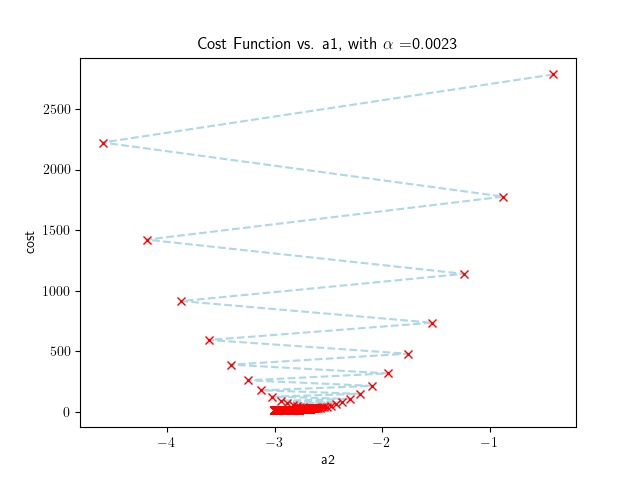We have discussed the multivariate linear regression problem in the previous posts, and we have seen that in this case the hypothesis function becomes:
ˆy=a0+a1x1+a2x2+⋯+anxn
If we define x0, such that x0=1, then the hypothesis function becomes:
ˆy=a0x0+a1x1+a2x2+⋯+anxn
Let us now consider a dataset of m points. we can therefore calculate the hypothesis function for each point,
ˆy(1)=a0x(1)0+a1x(1)1+a2x(1)2+⋯+anx(1)n
ˆy(2)=a0x(2)0+a1x(2)1+a2x(2)2+⋯+anx(2)n
…
ˆy(m)=a0x(m)0+a1x(m)1+a2x(m)2+⋯+anx(m)n
where x(i)1 is the first feature of the ith point and,
xi0=1∀i.
we can express the equation of the hypothesis function shown above as a matrix multiplication. Let us start by defining the matrix X as the matrix of features, such that;
X=(x(1)0x(2)0…x(m)0x(1)1x(2)1…x(m)1⋮⋮⋮⋮x(1)nx(2)n…x(m)n)
where, for example, x(2) or the second feature point,
x(2)=(x(2)0x(2)1⋮x(2)n)
the matrix of coefficients β as:
β=(a0a1⋮an)
and the matrix of predictions ˆY as:
ˆY=(ˆy(1)ˆy(2)⋮ˆy(m))
We can now calculate the hypothesis function as a matrix multiplication:
(ˆy(1)ˆy(2)⋮ˆy(m))=(x(1)0x(1)1…x(1)nx(2)0x(2)1…x(2)n⋮⋮⋮⋮x(m)0x(m)1…x(m)n)(a0a1⋮an)
ˆY=XT⋅β
We can now define the matrix of residuals as:
R=(ˆy(1)ˆy(2)⋮ˆy(m))−(y(1)y(2)⋮y(m))=(ˆy1−y1ˆy2−y2⋮ˆym−ym)
we can therefore update the coefficients β as:
(a0a1⋮an):=(a0a1⋮an)−αm(x(1)0x(2)0…x(m)0x(1)1x(2)1…x(m)1⋮⋮⋮⋮x(1)nx(2)n…x(m)n)⋅(ˆy1−y1ˆy2−y2⋮ˆym−ym)
β:=β−αmX⋅R
The cost function, J, which was defined in the previous post as:
J=12mm∑i=1(ˆy(i)−y(i))2
can be obtained as:
J(β)=12mβT⋅β
The full python code for this algorithm can be seen below. Numpy is used for the matrix operations, and the equations above are actually implemented in just the following four lines of code.
self.__y_hat = np.dot(self.__beta, self.__X.T)
# calculate the residuals
residuals = self.__y_hat - self.__y
# calculate the new value of beta
self.__beta -= (self.__alpha/self.__m) * np.dot(residuals, self.__X)
# calculate the cost function
cost = np.dot(residuals, residuals)/(2 * self.__m)
In the example, the code plots the cost function as a function of a2. We notice convergence is achieved after 6676 iterations for a reasonably large value of α.

import os
import matplotlib
matplotlib.rcParams['text.usetex'] = True
import matplotlib.pyplot as plt
import pandas as pd
import sys
import numpy as np
def multifeature_gradient_descent(file, alpha=0.0023, threshold_iterations=100000, costdifference_threshold=0.00001, plot=False):
X = None
Y = None
beta = None
full_filename = os.path.join(os.path.dirname(__file__), file)
training_data = pd.read_csv(full_filename, delimiter=',', header=0, index_col=False)
Y = training_data['y'].to_numpy()
m = len(Y)
X = training_data.drop(['y'], axis=1).to_numpy()
# add a column of ones to the X matrix to account for the intercept, a0
X = np.insert(X, 0, 1, axis=1)
print(X)
y_hat = np.zeros(len(Y))
# beta will hold the values of the coefficients, hence it will be the size
# of a row of the X matrix
beta = np.random.random(len(X[0]))
iterations = 0
# initialize the previous cost function value to a large number
previous_cost = sys.float_info.max
# store the cost function and a2 values for plotting
costs = []
a_2s = []
while True:
# calculate the hypothesis function for all training data
y_hat = np.dot(beta, X.T)
# calculate the residuals
residuals = y_hat - Y
# calculate the new value of beta
beta -= (alpha/m) * np.dot(residuals, X)
# calculate the cost function
cost = np.dot(residuals, residuals)/(2 * m)
# increase the number of iterations
iterations += 1
# record the cost and a1 values for plotting
costs.append(cost)
a_2s.append(beta[2])
cost_difference = previous_cost - cost
print(f'Epoch: {iterations}, cost: {cost:.3f}, beta: {beta}')
previous_cost = cost
# check if the cost function is diverging, if so, break
if cost_difference < 0:
print(f'Cost function is diverging. Stopping training.')
break
# check if the cost function is close enough to 0, if so, break or if the number of
# iterations is greater than the threshold, break
if abs(cost_difference) < costdifference_threshold or iterations > threshold_iterations:
break
if plot:
# plot the cost function and a1 values
plt.plot(a_2s[3:], costs[3:], '--bx', color='lightblue', mec='red')
plt.xlabel('a2')
plt.ylabel('cost')
plt.title(r'Cost Function vs. a1, with $\alpha$ =' + str(alpha))
plt.show()
return beta
if __name__ == '__main__':
file = 'data.csv'
alpha = 0.0023
threshold_iterations = 100000
costdifference_threshold = 0.00001
plot = False
beta = multifeature_gradient_descent(file, alpha, threshold_iterations, costdifference_threshold, plot)
print(f'Final beta: {beta}')